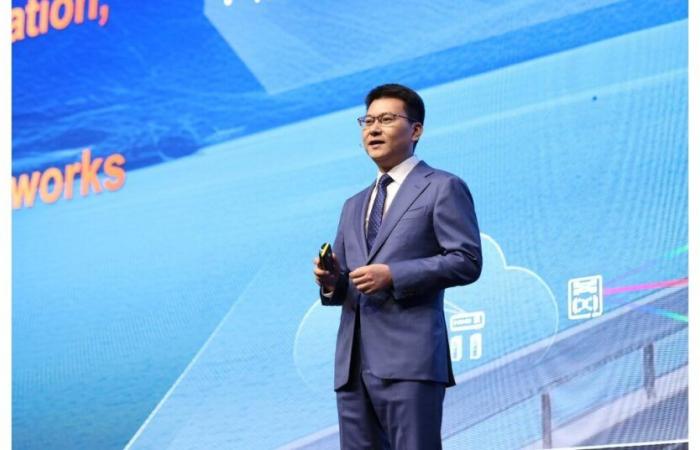ISTANBULTurkey, 4 november 2024 /PRNewswire/ — At the 10th Ultra-Broadband Forum (UBBF 2024) today, Bob Chenchairman of the Huawei Optical Business Product Line, delivered a keynote speech entitled Build AI-Centric F5.5G All-Optical Network for New Growth [AI-centrisch volledig optisch F5.5G-netwerk voor nieuwe groei bouwen].
Bob Chen, President of Huawei Optical Business Product Line, delivering a keynote speech
The AI era has arrived. General basic models are continuously improved for the rapid application in various industries. To date, more than 1300 basic models have been implemented. In addition, AI is widely used in mobile phones, PCs and cars. In the future, AI will be an indispensable part of terminals. AI helps us with trip planning, code generation, and quality inspection. In the future, AI will transform every aspect of our lives, work and production.
Bob Chen noted that in the AI era, some carriers will transform into all-service providers with AI, and some carriers will collaborate with third parties to provide services such as AI computing and AI applications. For carriers, building robust infrastructure networks and “enhancing computing with networks” will be key to business success in the AI era. The synergy between AI and cloud for devices and training in intelligent computing requires high network bandwidth, low latency and high reliability. Huawei continuously innovates F5.5G in optical transmission, optical access, and management and control platforms, so that carriers can build all-optical AI-centric networks.
In the field of optical transmission, Huawei’s leading optical switching technology is extended to data centers (DCs) and metro edges. First, optical switching DCs support the scale and efficiency improvement of AI computing. Huawei’s DC optical switching solution supports the expansion of intelligent computing from 1,000 cards to millions of cards based on ultra-dense ports and ultra-low power consumption. Compared to traditional solutions, the failure rate is approximately 20% lower by removing the optical modules. Furthermore, with all-optical switching at the metro edges, Huawei helps carriers build 1 ms, 5 ms and 10 ms latency circles through mesh networking. The all-optical one-hop connection for end-to-end all-optical switching from the backbone to the metro enables ultimate AI experiences. To date, more than 50 carriers around the world have extended optical switching to metro edges and built 1 ms metro networks.
In the field of optical access noticed Bob Chen that fixed broadband must provide premium services. Fixed broadband connections are based on fiber optic connections and provide a deterministic and guaranteed service experience for every user. Globally, there are three ways to monetize fixed broadband: monetization of coverage, monetization of bandwidth and monetization of experience.
First, monetization of coverage. Currently, more than 28% of users worldwide do not have a fiber optic connection available. Therefore, fiber coverage must be accelerated to capture the demographic dividend. Huawei solutions, including QuickConnect ODN and AirPON for all scenarios, can help carriers set up a network quickly and at low cost.
Second, bandwidth monetization. First, some carriers have rolled out fiber broadband, but their package rates are only tens of mbps. As a result, optical fibers do not reach their value. Therefore, we recommend gradually upgrading packages to offer more competitive broadband services. Second, some carriers offer gigabit packages, but the experience is poor and video often freezes. The root cause is that GPON is used to deliver the gigabit packages. Therefore, GPON should be upgraded to 10G PON as soon as possible to provide better network experiences.
Finally comes the monetization of experience. The industry has now reached a consensus on the evolution from single fiber FTTH to single network FTTR. FTTR networks can deliver an optimal experience for everyone, anytime, anywhere. To date, the number of FTTR users worldwide has exceeded 30 million. In addition, it accelerates Huawei de innovation and upgrade of FTTR+X to help carriers innovate AI applications, including AI plus storage, home monitoring and healthcare. Our ultimate goal is to support one smart home based on one FTTR network.
For the management and control platform, Huawei uses digital twin and AI base models to improve user experience and O&M efficiency in premium broadband and premium transmission solution scenarios. Huawei’s Premium Broadband solution uses automatic debugging to implement minute-level network fault diagnosis and proactive correction of poor QoE, reducing user complaints by 30%. The Premium Transmission solution uses automatic online scheduling to reduce the time to market of the new service from months to hours.
“Over the next decade, AI will rapidly become popular,” he said Bob Chen. “Huawei hopes to work with industry partners to build an AI-centric all-optical F5.5G network, extend optical switching to data centers and metro edges, build premium networks for optical access by monetizing coverage, bandwidth and experience , and fully inject AI capabilities into the management and control platform. In this way, AI will become popular much faster and we can jointly realize new business growth in the intelligent era!”
Photo – https://mma.prnewswire.com/media/2547495/image_5009699_30459576.jpg






